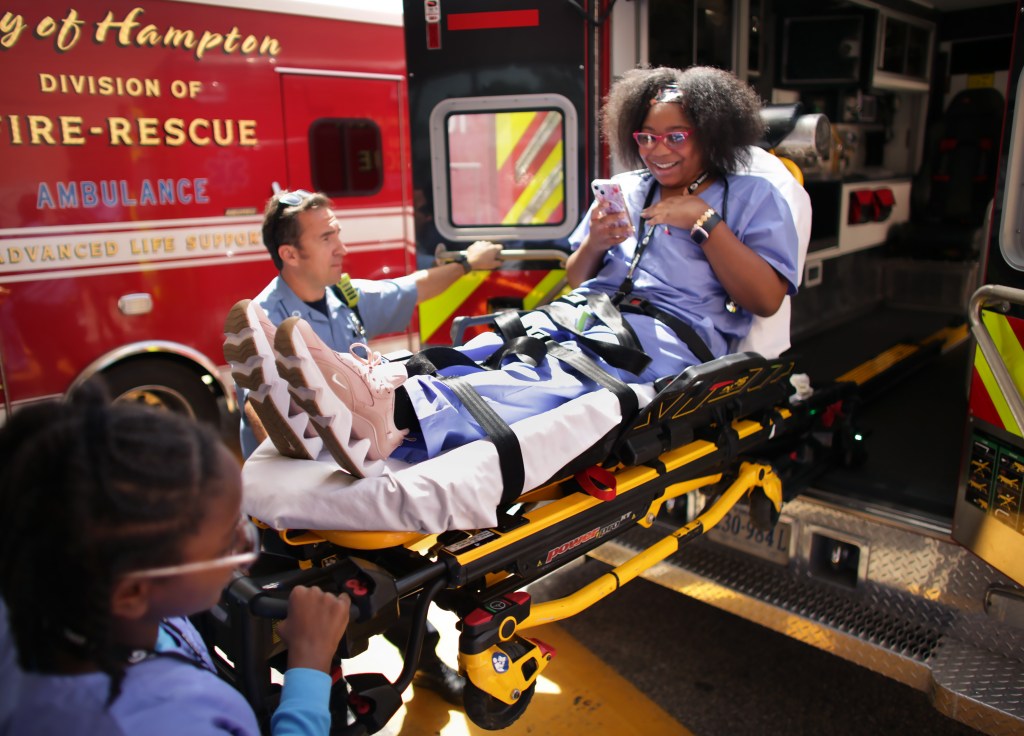HAMPTON — Dressed in baby blue scrubs and with a stethoscope around her neck, 13-year-old Alona Brown stood outside the emergency room at Sentara Careplex Wednesday morning, waiting for an ambulance. As soon as the ambulance arrived, Alona and her peers, who attend Gildersleeve Middle School in Newport News, took turns climbing inside, pressing buttons to operate the stretcher and weighing down the paramedics’ backpacks.
The group of about 20 students, from seventh to ninth grade, spent a week at Sentara Health Career Camp, getting a glimpse into the world of medicine. Sentara’s seven hospitals hold sessions throughout the summer.
A Sentara nurse looks on as campers practice how to prevent excessive bleeding during Sentara Career Camp at the Sentara Careplex in Hampton on Thursday afternoon, June 20, 2024. (Steven M. Katz/The Virginian-Pilot)
Students are introduced to different professions and take part in hands-on activities. In addition to the ambulance visit, Wednesday’s schedule also included a “Stop the Bleeding” class, where students learned how to bandage a wound and apply a tourniquet.
Students worked on making “limbs” — styrofoam tubes wrapped in flesh-colored fabric with cutouts to represent wounds — and as one student was wrapping gauze around a wound, she asked the instructor if wrapping it too tightly would hurt it.
“It’s going to be very uncomfortable for them,” the teacher said, “but you’re saving their lives.”
Many students consider a career in the medical field because they want to help others.
Nurse Michelle Paxton teaches Kenzie Washington, left, how to “stop the bleed” during Sentara Career Camp at Sentara Careplex in Hampton on Thursday afternoon, June 20, 2024. (Steven M. Katz/The Virginian-Pilot)
Liana Gonzalez, 12, has always wanted to be a doctor ever since her great-grandmother suffered a fatal stroke several years ago.
“It made me want to help more people like her,” said Liana, a seventh-grader at Booker T. Washington Middle School in Newport News. She said she watched a lot of medical documentaries and that Sentara Camp only strengthened her interest in becoming a doctor. She especially enjoyed the cardiology class on blockages in the heart.
Reagan Mizell, 14, wants to become a cardiologist and help people, but the Menchville freshman said her favorite memory so far was visiting the maternity ward, where students played a game where they had to dress baby dolls with one hand, and she won.
Sentara officials say the camps are a pipeline strategy to address the health care worker shortage.
“When these kids grow up, we want them to be taken care of,” said Iris Lundy, the hospital’s vice president of health equity.
The camp also aims to increase diversity in the workforce: Sentara staff partners with schools to encourage students from underrepresented communities to apply to the program.
“The literature shows that if you can identify with the person sitting next to you, you’ll do better,” Lundy says.
Sylvia Garcia Romero, the hospital’s director of diversity and inclusion, said patients trust and feel more comfortable with health care providers who can empathize with them. Having a more diverse workforce means patients are more likely to find health care providers who speak their language, understand their culture and share their religion. These things allow professionals to meet patients’ needs, whether that be accommodating dietary restrictions, allowing extra visitors because of the hospital’s family-centered culture or bringing in spiritual leaders for support.
Garcia Romero said diversity is also important to creating a more inclusive work environment.
Nour Habib, nour.habib@virginiamedia.com

